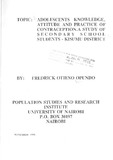ADOLESCENTS KNOWLEDGE, ATTITUDE AND PRACTICE OF CONTRACEPTION.A STUDY OF S E C O N D A R Y S C H O O L STUDENTS - KISUMU DISTRICT

View/
Date
1998Author
FREDRICK, OTIENO ,O
Type
ThesisLanguage
enMetadata
Show full item recordAbstract
The main objective of this study was to examine the knowledge, attitudes and practice of
contraception among the adolescents in secondary schools in Kisumu District. A sample of 400
students aged between 14 and 20 years was randomly drawn from the student population within the
district.
In the study, social, cultural, economic and demographic variables are examined. The social
variables include parents level of education, students’ exposure to mass media, and the effect of
HIV/AIDS. Cultural variables include parents religion, family composition desire, and desired
family size. Economic variables include parents occupation and usual place of residence. Finally,
demographic variables include age, sex, number of siblings, birth order type of parental union
(marriage) and the students’ age at first sexual intercourse.
The list of all secondary schools in Kisumu District provided the sampling frame from which
sample schools were selected. From the selected schools, the next stage was to select the classes
and the individual respondents. Random sampling was done in each and every, stage and the data
was collected by the use of questionnaires.
The major statistical techniques used in data analysis are frequencies, percentages, cross
tabulation, chi-square, multiple regression and logistic regression analysis . The smdy found that
most of the adolescents are aware of family planning methods but they were not familiar with the
application of most of the methods. Mass media and specifically radio (88.5 %) and newspapers
(73%) were the main and the most frequent source of information on family planning methods.
Most adolescents are in favour of contraception and they are also of the opinion that family planning
IV
education should be introduced in the school syllabus.
The number of contraceptive methods known and tire number of contraceptives whose
application are known is best explained by adolescents parents high level of education, those whose
age at first sexual intercourse is between 16 to 20 years, and those of the protestant faith. The
family planning methods known to the adolescents were as follows: Condoms (93.5 %), Pill (80.3
%) and Injection (59.8 %). While Norplant (8.3%) was the least known. It was also found that
adolescents have positive attitude towards contraceptive mainly because of HIV/AIDS pandemic.
With regard to actual practice, about 24 % of the adolescents were using contraceptives at
the time of the survey. The condom followed, by the pill are the main contraceptive methods used
by both male and female adolescents. This is mainly due to the strong attitude they have that
condom is the safest way of preventing unwanted pregnancy and sexually transmitted diseases
including HIV/AIDS. The results also shows that female adolescents were using contraceptives
more than their male counterparts. Practice of contraceptives is also best explained by the
adolescents high birth order, the fear of adverse effects of HIV/AIDS, parents high level of education
and occupation, and adolescents age at first sexual intercourse between 16 to 20 years.
It is recommended that family life education be introduced in schools wjjh a view of making
teenagers understand the consequences of early sexual intercourse and how they avoid it. Parents
and teachers have a role to play in counselling adolescents on family life education and more
importantly on HIV/AIDS which is making significant in-road among the adolescents population,
radio, newspapers and books/pamphlets should be used to reach the teenagers on family planning
issues.
Rights
Attribution-NonCommercial-NoDerivs 3.0 United StatesUsage Rights
http://creativecommons.org/licenses/by-nc-nd/3.0/us/Collections
The following license files are associated with this item:

